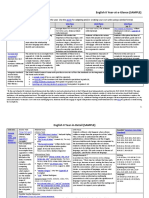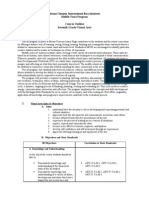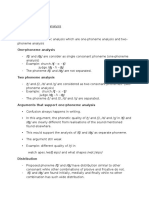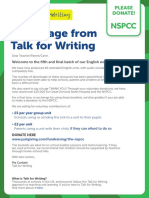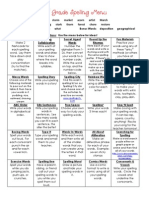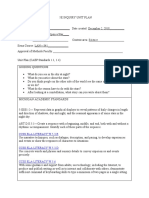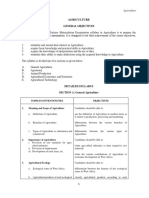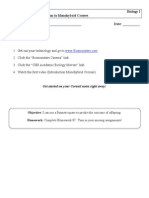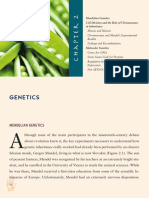Biology Gen Inherit Lab
Biology Gen Inherit Lab
Uploaded by
MasOom Si ChuRailCopyright:
Available Formats
Biology Gen Inherit Lab
Biology Gen Inherit Lab
Uploaded by
MasOom Si ChuRailOriginal Description:
Original Title
Copyright
Available Formats
Share this document
Did you find this document useful?
Is this content inappropriate?
Copyright:
Available Formats
Biology Gen Inherit Lab
Biology Gen Inherit Lab
Uploaded by
MasOom Si ChuRailCopyright:
Available Formats
Biology 9
Genetics and Inheritance Lab
Objectives:
Determine your own phenotype and probable genotype for some commonly inherited characteristics.
Identify the possible genotypes and phenotypes resulting from various genetic crosses and understand
their patterns of inheritance.
Solve problems involving autosomal dominant, autosomal recessive, and X-linked recessive disorders.
PART 1: Autosomal Dominant and Recessive Traits in Humans
Work with your lab partners to determine and record your phenotype for the traits listed in the first
column of the following table.
Determine your probable genotype and record it in fourth column of the table.
Your instructor will tally the phenotypes for each trait so that you can complete the last two columns of
the table.
Are dominant phenotypes always the most common in a population? ______________________
Trait: d = dominant
r = recessive
Your
Phenotype
Possible
Genotypes
Your
Probable
Genotype*
Total # in
class
% of
Class with
Dominant
Trait
Hairline:
Widow's peak (d)
WW or Ww
Straight hairline (r)
ww
Earlobes:
Unattached (d)
EE or Ee
Attached (r)
ee
Skin pigmentation:
Freckles (d)
FF or Ff
No freckles (r)
ff
Tongue rolling:
Can roll tongue (d)
TT or Tt
Can't roll tongue (r)
tt
Mid-digital hair:
Present (d)
HH or Hh
Absent (r)
hh
Hitchhiker's thumb:
TT or Tt
Last segment can't be bent
backward (d)
tt
Segment can be bent
backward >45 degrees (r)
Finger length:
Short fingers (d)
SS or Ss
Long fingers (r)
ss
Cleft chin:
Present (d)
CC or Cc
Absent (r)
cc
*Please indicate if you think you know for sure your genotype (i.e., you know both parents phenotypes)
1
PART 2: Monohybrid Crosses and Complete Dominance
Recall that gametes are haploid and contain only one of two homologous pairs of chromosomes. This
means that only one allele is present for a specific trait.
The genetic makeup or alleles present in an organism is its genotype. The physical characteristics are
its phenotype the expression of which can sometimes be influenced by environmental factors.
For each of the following diploid genotypes, indicate the possible genotypes of the gametes.
Diploid genotype
GG
gg
Gg
Gamete genotype
During fertilization, two gametes fuse and the diploid condition is restored. Give the diploid genotype
produced by the fusion of the following gamete genotypes.
Gamete genotype X Gamete genotype
g X g
G X g
G X G
Diploid genotype
Cleft chin is determined by a single gene consisting of two alleles, C and c. An individual whose
genotype is CC or Cc has cleft chin (Think Kirk and Michael Douglas). This is the dominant condition.
The recessive phenotype, the absence of a cleft chin, occurs only when the genotype is cc. In the case
of complete dominance, the dominant allele completely masks the expression or affect of the recessive
allele. Note that cleft chin is much less prominent among females.
When both alleles in a nucleus are identical, the nucleus is homozygous. Those having both dominant
alleles are homozygous dominant. When both recessives are present in the same nucleus, the
individual is said to be homozygous recessive for the trait.
Suppose a man has the genotype CC. What is the genotype of his gametes (sperm)? __________
Suppose a woman does not have cleft chin. What is her genotype? ___________. What allele does her
gametes (ova) carry? __________
Suppose these two individuals reproduce. Calculate the possible genotypes and phenotypes using a
Punnett Square.
What are the chances their children will have cleft chin? __________
2
PART 3: X-Linked Crosses
The sex chromosomes carry genes that affect traits other than the individual's sex. Genes on the sex
chromosomes are called sex-linked genes. The vast majority of sex-linked genes have alleles on the X
chromosome and are called X-linked genes. Most often, an abnormal condition is recessive.
Color blindness is an X-linked trait. During the Senses lab you tested yourself to determine whether or
not you were color-blind. What were the results? ______________________________________
If you found that you are color blind, what is your genotype? _______________
If you found that you are not color blind, what is your genotype? _______________
Assume you are a female and are not color blind. You can judge whether you are homozygous or
heterozygous by knowing if any member of your family is color-blind.
o If your father is color-blind, what is your genotype? __________
o If your mother is color-blind, what is your genotype? _________
o If you know of no one in your family who is color blind, what is your probable genotype?
__________
The only color-blind member of Talia's family is her brother.
o What is her brother's genotype? __________
o What is her father's genotype? __________
o What is her mother's genotype? __________
o What is Talia's genotype if she has a color-blind son? __________
PART 4: Genetics Problems Involving Autosomal Dominant, Autosomal Recessive, and X-Linked
Recessive Disorders
Example of an autosomal recessive disorder:
Cystic Fibrosis (CF) is the most common inherited genetic disorder in the U.S. One out of every 2000
births is a CF baby. A couple wants to have a baby, but both the husband and wife have relatives who
have died of CF. They go for genetic screening to see if they carry the diseased allele for this gene. The
results of the testing revealed that the man does not have the CF allele but the woman does.
o
o
o
o
o
What is the genotype of man? __________
What is the genotype of woman? __________
What type of sperm can the man make? __________
What type of eggs can the woman make? __________
Draw a Punnett square to determine the possible genotypes of their children:
o Is it possible for them to have a CF child? _______
o What is the chance that they will have a child that is a carrier? __________
General statements for the pattern of inheritance of autosomal recessive traits or disorders:
1. Two people without the disorder (or trait) can always have a child with the disorder (trait).
2. The disorder (trait) often skips several generations before reappearing.
3. The disorder (trait) affects boys and girls in equal proportions.
3
Example of an autosomal dominant disorder:
Huntington disorder is a progressive degeneration of the nervous system that begins at middle age and
results in an early death. It is caused by a single autosomal gene mutation that acts in a dominant
fashion.
o A 40-year old man was just diagnosed with Huntington disorder.
What could his genotypes be? __________________
o His wife went for genetic screening for the Huntington allele and learned that she did not have it.
What is her genotype? __________
o Assume it was determined through genetic screening that the husband only had one copy of the
Huntington allele. What must his genotype be? __________
o Draw a Punnett square to determine the potential genotypes of their children:
o Circle the genotypes of the children who have the Huntington allele.
o This couple has a 12-year old son. What is the chance that he inherited the disorder? _________
General statements for the pattern of inheritance of autosomal dominant traits or disorders:
1. Two people without the disorder (or trait) can NEVER have a child with the disorder (trait).
2. The disorder (trait) is present in every generation.
3. The disorder (trait) affects boys and girls in equal proportions.
Example of an X-linked recessive disorder:
Hemophilia, the inability of blood to clot, is caused by a recessive mutation of a gene on the X
chromosome. Suppose a normal man and a woman who is a carrier for hemophilia have children.
o Complete the Punnett square below to show the possible types of children. Label the sex and
genotype of each. Remember to use notation reflecting the X and Y chromosomes
o What is the chance that they have a hemophiliac child? __________
o What sex will the hemophiliac child always be? __________
o At the hospital, just after their baby boy is born, the doctor informs them that there is a __________
chance that their boy is a hemophiliac.
General statements for the pattern of inheritance of X-linked recessive traits or disorders:
1. Two people without the disorder (or trait) can always have a BOY with the disorder (trait).
2. The disorder (trait) often skips several generations before reappearing.
3. The disorder (trait) affects boys much more often than girls.
4
You might also like
- Come On Rain s1Document24 pagesCome On Rain s1api-259057314No ratings yet
- Lli-Orange Lesson 1Document3 pagesLli-Orange Lesson 1api-353854978No ratings yet
- First Grade Community Unit OverviewDocument5 pagesFirst Grade Community Unit OverviewKristen Coughlan100% (5)
- Macbeth Lesson Plan 6Document16 pagesMacbeth Lesson Plan 6Anne MooneyNo ratings yet
- Bill Nye Biodiversity Video QuestionsDocument2 pagesBill Nye Biodiversity Video Questionsapi-334125776100% (1)
- Learning Environment Design Guide TemplateDocument3 pagesLearning Environment Design Guide Templateapi-377383537100% (1)
- Year Plan English Language Arts Grade 10 SampleDocument5 pagesYear Plan English Language Arts Grade 10 SampleAmiga MiNo ratings yet
- TipsForParentsReadingAtHome PDFDocument2 pagesTipsForParentsReadingAtHome PDFOxana MarinescuNo ratings yet
- Csec PhysicsDocument2 pagesCsec PhysicsMasOom Si ChuRailNo ratings yet
- Inherited Human Traits HandoutsDocument17 pagesInherited Human Traits HandoutsFadzMieraNo ratings yet
- Day Four Ubd Lesson PlanDocument4 pagesDay Four Ubd Lesson Planapi-269729950No ratings yet
- Dihybrid Guinea Pigs PDFDocument2 pagesDihybrid Guinea Pigs PDFAndevie Balili IguanaNo ratings yet
- Lesson Plan 7 Grade 6 Ted Harrison Art ProjectDocument2 pagesLesson Plan 7 Grade 6 Ted Harrison Art Projectapi-372889215100% (1)
- Star Literacy Programme 2011Document40 pagesStar Literacy Programme 2011Juene IzannieNo ratings yet
- PoetryDocument15 pagesPoetryIzzati Qurrotul A'yun100% (2)
- 7th Grade Visual Arts Course OutlineDocument5 pages7th Grade Visual Arts Course OutlineMaureen Cusenza100% (1)
- AP Art History SyllabusDocument8 pagesAP Art History SyllabusNikki ScheutzowNo ratings yet
- Beginning of The Year - Parent SurveyDocument2 pagesBeginning of The Year - Parent Surveymcrouse88No ratings yet
- Fall 2014 IPG Greek and Roman Titles and Essential ClassicsDocument46 pagesFall 2014 IPG Greek and Roman Titles and Essential ClassicsIndependent Publishers GroupNo ratings yet
- Rhyme: Example: Brat, Fat, Mat, SatDocument33 pagesRhyme: Example: Brat, Fat, Mat, SatGuy Minecraft100% (1)
- Books For Grades 1 and 2Document2 pagesBooks For Grades 1 and 2Anonymous K9cINmNNo ratings yet
- Teacher Guide: Better Music Teaching!Document9 pagesTeacher Guide: Better Music Teaching!Elena Sushilova BykovaNo ratings yet
- Sciencepalooza: A Collection of Science Poetry for Primary and Intermediate StudentsFrom EverandSciencepalooza: A Collection of Science Poetry for Primary and Intermediate StudentsNo ratings yet
- Teach RhymeDocument10 pagesTeach RhymeMari Rañada SantosNo ratings yet
- Drama Theory and Primary School LearningDocument5 pagesDrama Theory and Primary School LearningLaurieNo ratings yet
- Reading Engagement: Summer DiscoveryDocument9 pagesReading Engagement: Summer DiscoveryMarnieKanarekNo ratings yet
- Let Them Have Books: A Formula for Universal Reading ProficiencyFrom EverandLet Them Have Books: A Formula for Universal Reading ProficiencyNo ratings yet
- Kindergarten ScienceDocument21 pagesKindergarten SciencehongbongNo ratings yet
- My List of Prefixes: Prefix ExampleDocument2 pagesMy List of Prefixes: Prefix ExamplenorhataNo ratings yet
- Epic Hero Epithet Lesson PlanDocument4 pagesEpic Hero Epithet Lesson PlanSamantha Bledsoe100% (1)
- Phonemic Analysis NotesDocument3 pagesPhonemic Analysis Notessyz1eNo ratings yet
- Tracking Pyp Recommendations - Sheet1Document4 pagesTracking Pyp Recommendations - Sheet1api-267835665No ratings yet
- UDL Lesson Plan Template - Revised 06102020Document4 pagesUDL Lesson Plan Template - Revised 06102020Tiara RNo ratings yet
- Do Your Ears Hang Low 1Document1 pageDo Your Ears Hang Low 1Christine SimpsonNo ratings yet
- Culturally Responsive ToolkitDocument21 pagesCulturally Responsive ToolkitMariaNo ratings yet
- Riotous Rhymes, Grades PK - 2: Start Students on the Road to Reading with the Fun of Working with RhymesFrom EverandRiotous Rhymes, Grades PK - 2: Start Students on the Road to Reading with the Fun of Working with RhymesNo ratings yet
- First Grade: Guided Reading Levels E, F, G, H, I, J: Title Author Call NumberDocument21 pagesFirst Grade: Guided Reading Levels E, F, G, H, I, J: Title Author Call NumberTariq AtassiNo ratings yet
- Kids Reading Games DominoesDocument15 pagesKids Reading Games DominoesLowen BurgosNo ratings yet
- Lesson Plan: Flocabulary POV Song POV PreziDocument7 pagesLesson Plan: Flocabulary POV Song POV Preziapi-511021657No ratings yet
- Odysseus, the Hero of Ithaca: Adapted from the Third Book of the Primary Schools of Athens, GreeceFrom EverandOdysseus, the Hero of Ithaca: Adapted from the Third Book of the Primary Schools of Athens, GreeceNo ratings yet
- Talk For Writing - Y3-Unicorn-FDocument33 pagesTalk For Writing - Y3-Unicorn-FChong Beng LimNo ratings yet
- Play and GamesDocument29 pagesPlay and GamesMadalina madaNo ratings yet
- All of the Above: Essays on Teaching English as a Foreign LanguageFrom EverandAll of the Above: Essays on Teaching English as a Foreign LanguageNo ratings yet
- The Egypt GameDocument3 pagesThe Egypt GamebabujunkNo ratings yet
- Interactive Storybook Reading - Making The Classroom Read-Aloud Program A Meaningful Learning Experience-2Document8 pagesInteractive Storybook Reading - Making The Classroom Read-Aloud Program A Meaningful Learning Experience-2api-253180182No ratings yet
- Spelling Menu R-Controlled VowelsDocument1 pageSpelling Menu R-Controlled VowelsLisl WindhamNo ratings yet
- Unit Plan Science 5th GradeDocument5 pagesUnit Plan Science 5th GradeNatalie ShaldaNo ratings yet
- More Quick Hits: Successful Strategies by Award-Winning TeachersFrom EverandMore Quick Hits: Successful Strategies by Award-Winning TeachersS. Holly StockingRating: 4 out of 5 stars4/5 (1)
- Kindergarten EllDocument78 pagesKindergarten Elllcpender0% (1)
- Eve Bunting Author Study Unit PlanDocument13 pagesEve Bunting Author Study Unit Planobcapemay100% (2)
- A Case Study of Drama Education Curriculum For Young Children in Early Childhood ProgramsDocument15 pagesA Case Study of Drama Education Curriculum For Young Children in Early Childhood Programsacmalonzo100% (1)
- Nursery Medium Term PlanningDocument1 pageNursery Medium Term Planningapi-199453431No ratings yet
- Cape Chemistry Unit 2Document3 pagesCape Chemistry Unit 2MasOom Si ChuRailNo ratings yet
- Transport in Plants PDFDocument26 pagesTransport in Plants PDFMasOom Si ChuRail100% (2)
- A Level Biology CapeDocument1 pageA Level Biology CapeMasOom Si ChuRailNo ratings yet
- A Level BiologyDocument2 pagesA Level BiologyMasOom Si ChuRailNo ratings yet
- Chemguide - Questions: Structural IsomerismDocument1 pageChemguide - Questions: Structural IsomerismMasOom Si ChuRailNo ratings yet
- Cape BiologyDocument2 pagesCape BiologyMasOom Si ChuRailNo ratings yet
- Cape Biology Unit 2Document2 pagesCape Biology Unit 2MasOom Si ChuRail100% (1)
- Cape Chemistry Unit 2Document3 pagesCape Chemistry Unit 2MasOom Si ChuRailNo ratings yet
- USABO Study QuestionsDocument45 pagesUSABO Study Questionsprincess2011No ratings yet
- AgricultureDocument16 pagesAgricultureUmar MuhammadNo ratings yet
- ds87 Intro Monohybrid CrossesDocument7 pagesds87 Intro Monohybrid Crossesapi-110789702No ratings yet
- Essentials of Human Development A Life Span View 2nd Edition Kail Test BankDocument37 pagesEssentials of Human Development A Life Span View 2nd Edition Kail Test Bankmatthewprattiipzwskbcdrx100% (14)
- Final Demonstration in Teaching A Learning Plan in Science Grade 8Document12 pagesFinal Demonstration in Teaching A Learning Plan in Science Grade 8Leyham AlfonsoNo ratings yet
- Principles of Inheritance and Variation NCERT Highlight by SeepDocument28 pagesPrinciples of Inheritance and Variation NCERT Highlight by SeepskindustrieshelplineNo ratings yet
- High-Throughput Approach To Detection of Knockdown Resistance (KDR) Mutation in Mosquitoes Culex QuiDocument10 pagesHigh-Throughput Approach To Detection of Knockdown Resistance (KDR) Mutation in Mosquitoes Culex QuiManas SarkarNo ratings yet
- Question Bank GeneticsDocument17 pagesQuestion Bank GeneticsTapajyoti RouthNo ratings yet
- Exercises Genetics USTH2022Document15 pagesExercises Genetics USTH2022yungiang157No ratings yet
- I - Whether A or BDocument18 pagesI - Whether A or BRhon Zeus SoledadNo ratings yet
- The Human Species: An Introduction To Biological Anthropology by John Relethford - 9e, TEST BANK 0078034981Document18 pagesThe Human Species: An Introduction To Biological Anthropology by John Relethford - 9e, TEST BANK 0078034981jksnmmmNo ratings yet
- PV92 PCR Kit ManualDocument100 pagesPV92 PCR Kit ManualdnajenNo ratings yet
- Mendelian PPTKATHLEENDocument71 pagesMendelian PPTKATHLEENMaricel PenaNo ratings yet
- Al Bio Past Paper 91-03 (Part IV) ADocument44 pagesAl Bio Past Paper 91-03 (Part IV) AAndrew CorbsNo ratings yet
- Dice DIce Baby Activity and Practice Quiz Lesson Observation 3Document12 pagesDice DIce Baby Activity and Practice Quiz Lesson Observation 3Victoria WarrenNo ratings yet
- Boyd, R., & Silk, J. B. (2008) - How Humans Evolved. Chapter 2. Genetics. (24 - 52) .Document29 pagesBoyd, R., & Silk, J. B. (2008) - How Humans Evolved. Chapter 2. Genetics. (24 - 52) .Paz Victoria Suarez PradaNo ratings yet
- Tumour Suppressor Genes CLS 712 2022-2023Document35 pagesTumour Suppressor Genes CLS 712 2022-2023Heba LahhamNo ratings yet
- ALL EST REAL Biology Exams BY DR. MAI ABD EL SalamDocument152 pagesALL EST REAL Biology Exams BY DR. MAI ABD EL Salamminhpham90012No ratings yet
- MudicraouioDocument44 pagesMudicraouioSunita KumarNo ratings yet
- Poligen & MultifaktorDocument49 pagesPoligen & MultifaktorLovina Falendini AndriNo ratings yet
- Molecular Basis of Inheritance PYQS Ans Key - 19189643 - 2023 - 06 - 05 - 12 - 38Document25 pagesMolecular Basis of Inheritance PYQS Ans Key - 19189643 - 2023 - 06 - 05 - 12 - 38Arsh DhawanNo ratings yet
- Eoc ReviewDocument115 pagesEoc Reviewapi-242405009100% (2)
- Development Theories 1 2Document66 pagesDevelopment Theories 1 2Aaryan GuptaNo ratings yet
- Henrys - ThalassemiaDocument8 pagesHenrys - ThalassemiaJovie Anne CabangalNo ratings yet
- Linkage and Recombination PDFDocument44 pagesLinkage and Recombination PDFVenkatesh JelliNo ratings yet
- Biol3451 Ch4 LectDocument60 pagesBiol3451 Ch4 LectcolabrinkNo ratings yet
- Chapter 9-Linkage and Genetic Mapping in EukaryotesDocument65 pagesChapter 9-Linkage and Genetic Mapping in EukaryotesSarah Afiqah100% (1)
- PEM 2020 Trial (No Solutions)Document31 pagesPEM 2020 Trial (No Solutions)HewadNo ratings yet
- Plant Gene Editing Through de Novo Induction of MeristemsDocument10 pagesPlant Gene Editing Through de Novo Induction of MeristemsCésar Claros GarcíaNo ratings yet
- Content Review PacketDocument9 pagesContent Review Packetapi-342334216100% (1)






